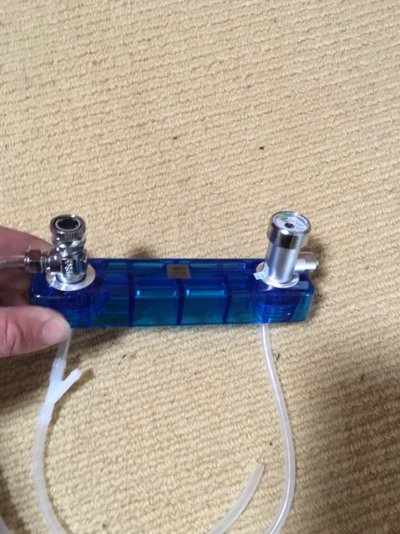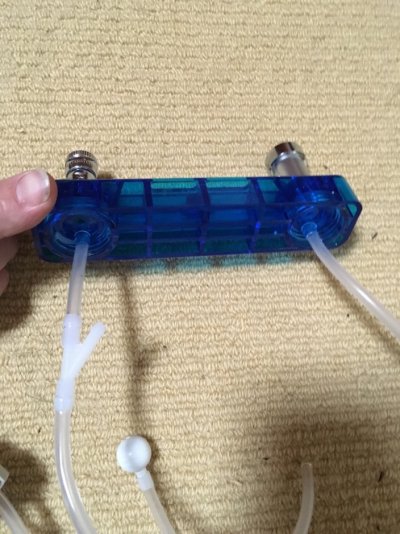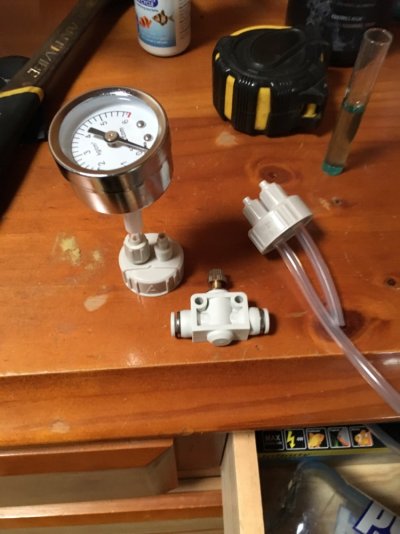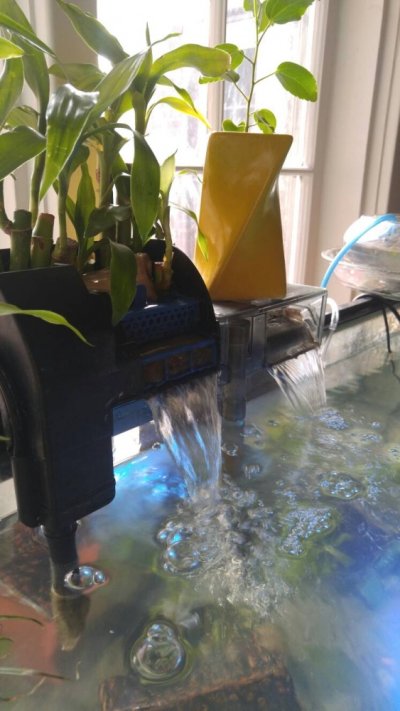nirbhao
Aquarium Advice Addict
I've been reading and searching, finding a lot of useful information. However, it's all about situations that are slightly different from mine in important ways. I'm going to lay out exactly what I have going on here and what I'm looking for.
This is the tank in question.
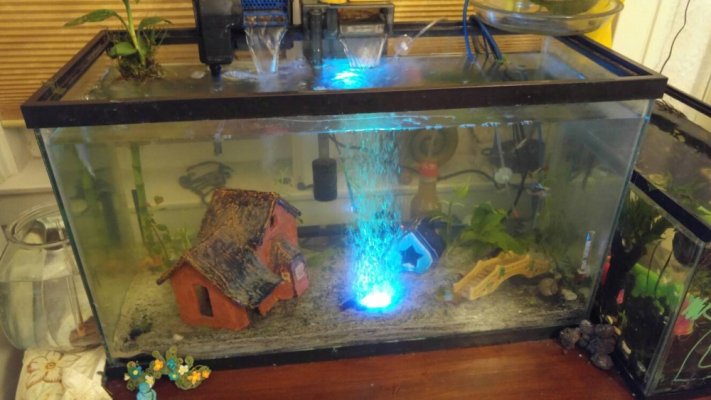
It's 29 gallons. It doesn't have a lid and it's in an east-facing window. I've heard those are both big no-nos, but obviously I'm doing it anyway. The spouse likes it that way. The plants grow out of the tank and the sunlight is the main lighting. There's an LED airstone that I'll get to as well. The temperature is consistently 82° F and pH 7.4.
The filters are an AquaClear 30 and a gutted Aqueon Whisper 10 that now holds biomax and purigen. I've removed all carbon. Air is fed during the day through an AquaTop AP100, split with the 10 gallon and little dish that houses baby snails. Because baby Japanese trapdoor and rabbit snails are apparently super delicious to the gourami and blue ram. I digress... The air comes through the LED airstone and one of those $2 airstone bars. Our whole air situation started with an undergravel filter, which had to go once we switched to sand substrate.
This is my brand new as of today CO2 system.
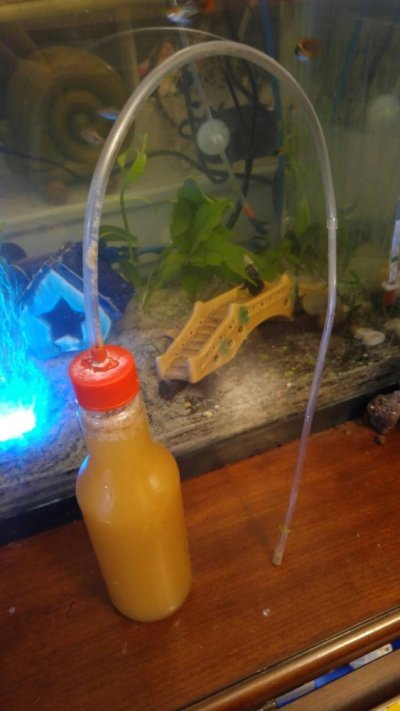
Keeping it super high tech.
I drilled a hole in the lid and superglued a check valve, attached flexible PVC airline to rigid airline. It's currently delivering 38 bubbles per minute.
Stock is 1 dwarf gourami, 1 blue ram, 4 guppies, 7 Harlequin rasboras, 3 rabbit snails, 3 mystery snails, and a Japanese trapdoor snail who is currently isolated because the fish are treating her like a snack machine.
I get no algae. At least, if I do, the snails take care of it before I ever see it.
My plants are a little of everything, which is definitely part of the problem. I have two types of ludwigia, argentine sword, "asian water fern," java ferns, and microsword fully submerged. There's an acorus and some lucky bamboo partially submerged. They aren't dying, but they aren't thriving. Many of these plants were given to me when I asked a guy at Petco how dead he thought one of those plants in the tubes are. He correctly inferred that I am comfortable buying less than perfect plants and bringing them back to health.
After bringing all of these plants home, my carbonate hardness dropped out, although I can't really call it that given that it had generally been between 9 and 12. Regardless, we hadn't been adding any carbon, only using LeafZone once a week. We added Flourish Excel and I've been dosing outright absurd amounts but still my carbonate hardness peaks at 3.
My husband hasn't actually used the words, "Stop spending so much money on the fish," but he may as well have, so anything I do needs to be either cheap or something we can make. He's a fabricator and welder, and I actually suspect he would have a lot of fun working on a CO2 system.
Questions!
1. Are we doing it totally backwards running the air pump during the day and not at night? Should we be using the air pump at all?
2. How long is it going to take to get the dissolved CO2 high enough to give the plants something to breathe?
3. Is it okay to leave the CO2 line in at night?
4. What else?
Thanks so much. You guys have been a huge help with everything else I've done so far.
This is the tank in question.

It's 29 gallons. It doesn't have a lid and it's in an east-facing window. I've heard those are both big no-nos, but obviously I'm doing it anyway. The spouse likes it that way. The plants grow out of the tank and the sunlight is the main lighting. There's an LED airstone that I'll get to as well. The temperature is consistently 82° F and pH 7.4.
The filters are an AquaClear 30 and a gutted Aqueon Whisper 10 that now holds biomax and purigen. I've removed all carbon. Air is fed during the day through an AquaTop AP100, split with the 10 gallon and little dish that houses baby snails. Because baby Japanese trapdoor and rabbit snails are apparently super delicious to the gourami and blue ram. I digress... The air comes through the LED airstone and one of those $2 airstone bars. Our whole air situation started with an undergravel filter, which had to go once we switched to sand substrate.
This is my brand new as of today CO2 system.

Keeping it super high tech.
I drilled a hole in the lid and superglued a check valve, attached flexible PVC airline to rigid airline. It's currently delivering 38 bubbles per minute.
Stock is 1 dwarf gourami, 1 blue ram, 4 guppies, 7 Harlequin rasboras, 3 rabbit snails, 3 mystery snails, and a Japanese trapdoor snail who is currently isolated because the fish are treating her like a snack machine.
I get no algae. At least, if I do, the snails take care of it before I ever see it.
My plants are a little of everything, which is definitely part of the problem. I have two types of ludwigia, argentine sword, "asian water fern," java ferns, and microsword fully submerged. There's an acorus and some lucky bamboo partially submerged. They aren't dying, but they aren't thriving. Many of these plants were given to me when I asked a guy at Petco how dead he thought one of those plants in the tubes are. He correctly inferred that I am comfortable buying less than perfect plants and bringing them back to health.
After bringing all of these plants home, my carbonate hardness dropped out, although I can't really call it that given that it had generally been between 9 and 12. Regardless, we hadn't been adding any carbon, only using LeafZone once a week. We added Flourish Excel and I've been dosing outright absurd amounts but still my carbonate hardness peaks at 3.
My husband hasn't actually used the words, "Stop spending so much money on the fish," but he may as well have, so anything I do needs to be either cheap or something we can make. He's a fabricator and welder, and I actually suspect he would have a lot of fun working on a CO2 system.
Questions!
1. Are we doing it totally backwards running the air pump during the day and not at night? Should we be using the air pump at all?
2. How long is it going to take to get the dissolved CO2 high enough to give the plants something to breathe?
3. Is it okay to leave the CO2 line in at night?
4. What else?
Thanks so much. You guys have been a huge help with everything else I've done so far.

